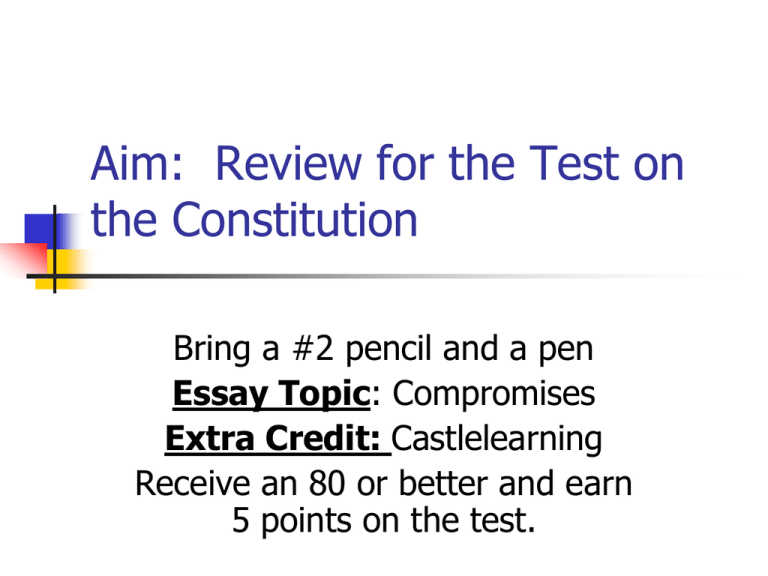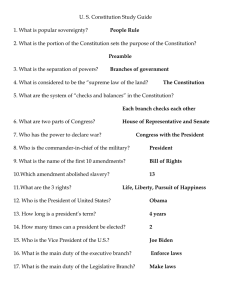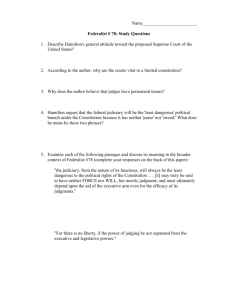Aim: Review for the Test on the Constitution
advertisement

Aim: Review for the Test on the Constitution Bring a #2 pencil and a pen Essay Topic: Compromises Extra Credit: Castlelearning Receive an 80 or better and earn 5 points on the test. Mayflower Compact Agreement signed by the Pilgrims before landing at Plymouth. Contract in which the colonists consented to be governed by a government that they created- self government. Common Sense Pamphlet written by Thomas Paine He wrote that it is ridiculous for the American colonies occupying a great continent, to be ruled by a tiny island like Britain. Declaration of Independence Written by Thomas Jefferson Purpose: Justify the reasons the colonies had decided to become the U.S.A. Key Ideas: People have natural rights Governments receive their power to govern from “the consent of the governed.” When government fails to protect those rights, people have the right to alter or abolish it. John Locke Social Contract. Right to life, liberty and property. Right to revolution. Ideas contained in the Declaration of Independence. Articles of Confederation Weak central government. States had all the power. States coined their own money States made foreign treaties. No Federal military. States did not have to pay taxes to the Federal government. Great Compromise Problem: Large states wanted representation based on population. Small states wanted equal representation. Solution: Bicameral Legislature- Congress. Senate- equal representation. House of Representatives based on population. Federalist Papers A series of persuasive essays in favor of ratification of the Constitution. Written by: Alexander Hamilton, John Jay, and James Madison. Federalist/ Anti- Federalist Federalist- supporter of ratification Anti-Federalist- Against ratification Bill of Rights was added to the Constitution to get the Anti-Federalists to ratify the Constitution. Judicial Review Power of the Supreme Court to declare a law unconstitutional. Example of the “unwritten Constitution.” Result of Marbury v. Madison. Checks and Balances Based on ideas of Montesquieu. Prevents one branch of government from becoming more powerful than the others. Example- A bill becoming a law. Preamble Introduction to the Constitution. States the purpose of government and their responsibilities to the citizens. Federalism The division of power between state and federal government. Delegated- Federal government (military) Reserved- state government (licenses) Concurrent- both (taxes) Separation of Powers Based on ideas of Montesquieu. Divides Federal government into three branches: Executive- enforce laws Legislative- make laws Judicial- interpret laws Republic Form of government from Ancient Rome. Citizens elect people to represent them. Amending Process Formally changing the Constitution. Congress approves by 2/3rd vote. ¾ of the states must ratify the amendment. Electoral College As assembly elected by the voters that meets every four years to formally elect the President. Winners of the popular vote have lost the presidency because they failed to win a majority of the electoral vote. Bill of Rights First ten amendments to the Constitution. Deal with Civil Liberties. Elastic Clause States that Congress can make all laws “necessary and proper” for carrying out the tasks listed in the Constitution. Stretches the powers of Congress.







